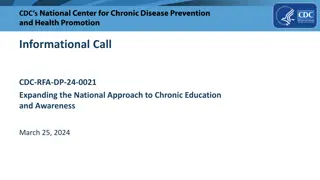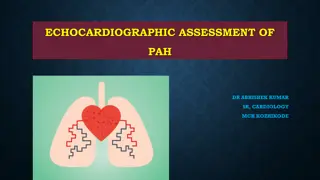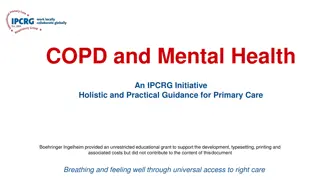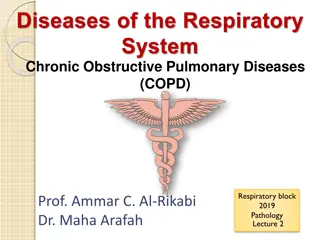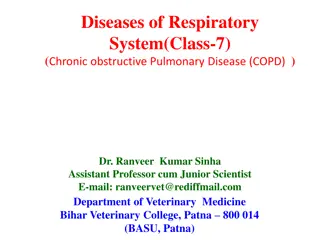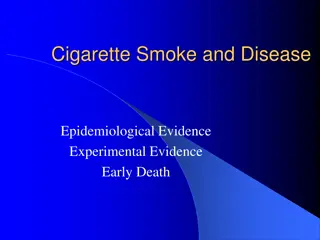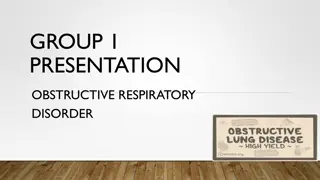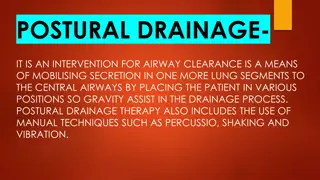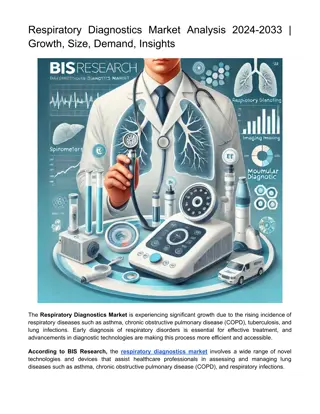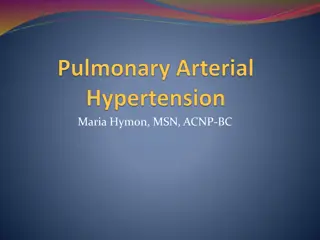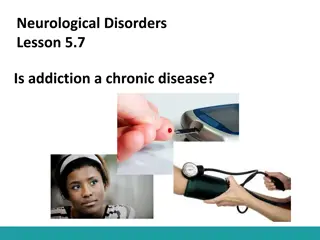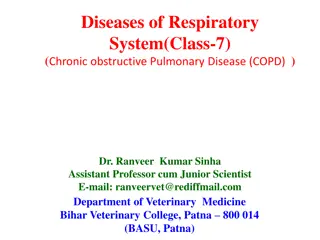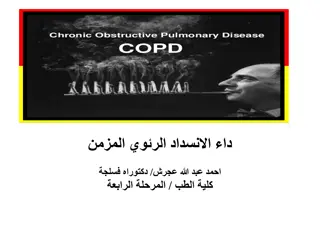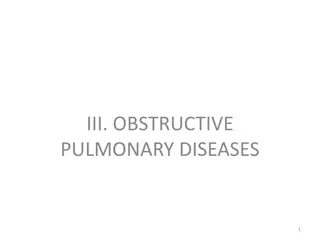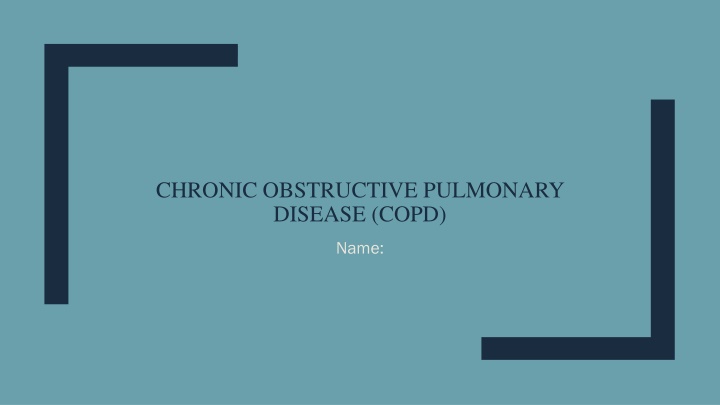
COPD: Causes, Symptoms, and Treatment
Chronic Obstructive Pulmonary Disease (COPD) is a common lung condition characterized by airflow obstruction, leading to symptoms like breathing difficulty, cough, and wheezing. Cigarette smoke, air pollution, and genetic factors are common causes. Learn about the anatomy, physiology, and etiology of COPD to better understand this chronic inflammatory disease.
Uploaded on | 3 Views
Download Presentation

Please find below an Image/Link to download the presentation.
The content on the website is provided AS IS for your information and personal use only. It may not be sold, licensed, or shared on other websites without obtaining consent from the author. If you encounter any issues during the download, it is possible that the publisher has removed the file from their server.
You are allowed to download the files provided on this website for personal or commercial use, subject to the condition that they are used lawfully. All files are the property of their respective owners.
The content on the website is provided AS IS for your information and personal use only. It may not be sold, licensed, or shared on other websites without obtaining consent from the author.
E N D
Presentation Transcript
CHRONIC OBSTRUCTIVE PULMONARY DISEASE (COPD) Name:
I HAVE READ AND UNDERSTAND THE PLAGIARISM POLICY AS OUTLINED IN THE SYLLABUS AND THE SECTIONS IN THE CATALOG RELATING TO THE IWU HONESTY/CHEATING POLICY. BY AFFIXING THIS STATEMENT TO THE TITLE PAGE OF MY PAPER, I CERTIFY THAT I HAVE NOT CHEATED OR PLAGIARIZED IN THE PROCESS OF COMPLETING THIS ASSIGNMENT. IF IT IS FOUND THAT CHEATING AND/OR PLAGIARISM DID TAKE PLACE IN THE WRITING OF THIS PAPER, I UNDERSTAND THE POSSIBLE CONSEQUENCES OF THE ACT/S, WHICH COULD INCLUDE EXPULSION FROM INDIANA WESLEYAN UNIVERSITY.
Background and Pathology COPD Chronic inflammatory lung disease causing obstructed airflow from the lungs. Symptoms: breathing difficulty, cough, sputum production and wheezing. Causes: long term exposure to gas/particulate matter (i.e. cigarette smoke) Two most common diseases associated with COPD: Emphysema and chronic bronchitis (MayoClinic, 2015) -Estimated to affect 32 million persons in the US and is the third leading cause of death -CDC analyzed data in and found that in all 50 states, the District of Columbia (DC), and Puerto Rico, 6.3% reported told they have COPD. (CDC, 2012) http://www.cdc.gov/copd /data.htm
All cigarette smokers have inflammation in lungs Those who develop COPD have increased or abnormal response to inhaling toxic agents. Results in mucous hypersecretion (chronic bronchitis), Tissue destruction (emphysema), Disruption of normal repair and defense mechanisms leading to fibrosis (bronchiolitis) Air travels down your trachea to the lungs through two large bronchi. Inside your lungs, these tubes divide into bronchioles to alveoli. The air sacs have very thin walls full of tiny blood vessels. The oxygen in the air you inhale passes into these blood vessels and enters your bloodstream. Lungs rely on bronchial tubes and air sacs to force air out COPD causes them to lose their elasticity and over expand, which leaves results in trapped air when you exhale.
Anatomy and Physiology of COPD http://www.doctortipster.com/wp-content/uploads/2011/08/COPD.jpg
Etiology Most common causes are: cigarette smoke, tobacco, second-hand smoke, air pollution, chemical fumes, dust (observed from workplace environments) Genetic condition: Alpha-1 antitrypsin (an-tee-TRIP-sin) deficiency (NIH, 2013) http://www.topnews.in/files/air-pollution-4564.jpg http://static.ddmcdn.com/gif/cigarette-tobacco-thirdhand-smoke-676357-.jpg
Pathogenesis Figure 1. Pathogenesis. (McNee, 2006)
Laboratory and Diagnostic Tests The formal diagnosis of COPD is made with spirometry ratio of forced expiratory volume in 1 second/forced vital capacity (FEV1/FVC) is less than 70% of that predicted diagnostic for a significant obstructive defect. Stage I (mild): FEV 1 80% or greater Stage II (moderate): FEV 1 50-79% Stage III (severe): FEV 1 30-49% Stage IV (very severe): FEV 1 less than 30% of predicted or FEV 1 less than 50% and chronic respiratory failure Arterial blood gas (ABG) Frontal and Lateral chest radiographs High-resolution CT (Medscape, 2015) http://www.medguidance.com/images/10409160/4-Stages-of-COPD.png
Additional Testing Tests Tests Hematocrit Patients with polycythemia (hematocrit greater than 52% in men or 47% in women) should be evaluated for hypoxemia at rest, with exertion, or during sleep Diuretics, beta-adrenergic agonists, and theophylline act to lower potassium levels transformation from mucoid in stable chronic bronchitis to purulent in acute exacerbations Abnormal pulse Test for hypoxia not related to cardiac Distance walked in 6 minutes is an indicator Test for hyper pulmonary hypertension Confirms hyper pulmonary hypertension Serum Potassium Sputum Evaluation Pulse oximetry Electrocardiography Walking Distance Two-dimensional echocardiography Right-sided heart catheterization (MedScape, 2015)
Signs and Symptoms Shortness of breath, particularly during physical activities Wheezing Tightness in the Chest Excess mucus in your lungs, throat-clearing A chronic cough resulting in sputum Blueness of the lips or fingernail Recurring respiratory infections Lack of energy http://s3.amazonaws.com/readers/2011/01/21/smoking_1.jpg Unintended weight loss (in later stages) (Mayo Clinic, 2015)
Other Symptoms Morning headaches (breathing decreases during sleep, which decreases oxygen comes resulting in more carbon dioxide in the blood) Increase in respiratory related symptoms Suddenly worse Constant episodes known as exacerbations (COPD.com, 2015) Exacerbations can be infection (bacterial or viral), air pollution, and changes in ambient temperature. (MacNee, 2006) http://www.globalasthmareport.org/2011/images/files/400px_pics/cartoon-COPD.jpg
http://blog.affinityhealth.org/wp-content/uploads/2011/08/inhaler.jpghttp://blog.affinityhealth.org/wp-content/uploads/2011/08/inhaler.jpg Treatment Stop Smoking! Refer Nicotine replacement products Medications Bronchodilators Inhaled steroids Oral Steroids Phosphodiesterase-4 inhibitors (new medication relaxes the airways) Theophylline Antibiotics (Mayo Clinic, 2015) http://cdn.zmescience.com/wp-content/uploads/2013/03/antibiotics.jpg
Lung Therapies Oxygen therapy. Oxygen therapy. Supplemental oxygen. Portable units Pulmonary rehabilitation program. Pulmonary rehabilitation program. These programs typically combine education, exercise training, nutrition advice and counseling. Surgery Surgery Surgery is an option for severe emphysema Lung Lung volume reduction surgery. volume reduction surgery. I Removal of damaged tissue. Expands diaphragm. Lung transplant Lung transplant. . Significant risks and lifetime medications (Mayo Clinic, 2015) https://edc2.healthtap.com/ht-staging/user_answer/avatars/331626/large/open-uri20120730-26217- 106cghr.jpeg?1386555973
Prognosis Variable. Good prognosis=early diagnosis and type of lung damage Deaths from COPD: Deaths from COPD: 124,181 annual deaths; 5.2% of deaths Cause Cause of death rank: of death rank: 5th top cause of death in 1999 is "Chronic Lower Respiratory Disease (RightDiagnosis.com, 2014). Prognosis has been reported based on the FEV1, FEV1 of less than 35 percent of predicted means very severe disease Estimate more than half of patients with very severe disease may not survive past four years. In addition to the FEV1, other factors that predict prognosis are Weight (very low weight is bad in this case), Distance walked in six minutes Degree of shortness of breath with activities. http://intelligenttravel.com.au/wp-content/uploads/2013/11/Quality-of-Life-pix.jpg
Prognosis cont BODE index: used to obtain prognosis for One-year, Two-year, and Four-year survival Ex. A person with FEV1 of 20%, shortness of breath easily, and ability to walk only 500 feet in 6 min = 2 year survival rate Important Questions for determining prognosis: How severe is your COPD based on pulmonary function tests (what is your forced expiratory volume in 1 second [FEV1])? Do you have higher than normal carbon dioxide levels? Are you using oxygen? How short of breath are you--at rest? --with mild activity? --with higher levels of activity? Can you walk very far or are you limited to a chair or bed? Have you ever participated in pulmonary rehabilitation? How is your weight? Are you very thin? Improve prognosis: Cigarette Cessation (University of Cincinnati, 2015)
Outcome and Complication Intervention should effect on lung function; therefore measurements obtained Spirometry: FEV1, FVC, and their ratio Look for significant differences How much must the FEV1 improve to be considered clinically significant? The American Thoracic Society and Global Initiative for Chronic Obstructive Lung Disease guidelines: increase in FEV1 of 200 ml plus a relative increase of 12% above baseline =significant Functional Outcomes Measuring symptoms: wheezing, coughing, sputum, Dyspnea (shortness of breath). Borg Scale: severity of Dyspnea: 10 point scale and Exercise Tests: Walking tests (6 min walk) and comparing results prior to intervention Two Two QOL indexes QOL indexes used used in COPD: the Saint George's Respiratory Questionnaire (SGRQ) in COPD: the Saint George's Respiratory Questionnaire (SGRQ) and the Chronic Respiratory Questionnaire (CRQ) the Chronic Respiratory Questionnaire (CRQ) Both indexes examine changes from interventions and natural events. The SGRQ: Symptoms, Activity, and Impacts. 0 (perfect health) to 100 (most severe status). A change in four units is the minimal clinically significant change. The CRQ has four components: Dyspnea, Fatigue, Emotional Function, and Mastery. (Gross et al., 2005) Complications: Respiratory Infection, Heart Problems, Lung Cancer, High Blood Pressure, Depression (MayoClinic, 2015) and
Nursing and COPD Increasing role of nurse in management of COPD Increase patient education and communication Scope Diagnosis Prescription Patient Monitoring Ongoing Evaluation of treatment Modification of Treatment Key Role in Treatment Managing and Handling patient concerns about safety and tolerability http://www.ncbi.nlm.nih.gov/pmc/articles/PMC3583441/
Questions for Classmates Patients are usually prescribed several COPD medications and have an complicated treatment course, as well as have a long-term pharmacologic treatment, which could lead to risk factors for other diseases associated with the medication. What should you, as a nurse be aware of when managing this disease? Why is it important for nurse practitioners to take a proactive approach to the safety and tolerability issues of patients with COPD?
References CDC. (2012). Chronic Obstructive Pulmonary Disease Among Adults United States, 2011. Retrieved from: http://www.cdc.gov/mmwr/preview/mmwrhtml/mm6146a2.htm COPD.com. (2015). Symptoms. Retrieved from: http://www.copd.com/about- copd/symptoms.html Gross, N., et al. (2005). Chronic Obstructive Pulmonary Disease Outcome Measurements. Proceedings of the American Thoracic Society. 267-271. Medscape. (2015). Chronic Obstructive Pulmonary Disease (COPD). Retrieved from: http://emedicine.medscape.com/article/297664-overview NIH. (2013). What causes COPD?. National Heart, Lung, and Blood Institute. Retrieved from: http://www.nhlbi.nih.gov/health/health-topics/topics/copd/causes Spencer, P. and Hanania, NA. (2013). Optimizing safety of COPD treatments: role of the nurse practicioner. J Multiidscip Healht. (6):53-63. http://www.ncbi.nlm.nih.gov/pmc/articles/PMC3583441/ University of Cincinnati. (2015). COPD (Chronic Obstructive Pulmonary Disease. Retrieved from: http://www.netwellness.uc.edu/healthtopics/copd/default.cfm

